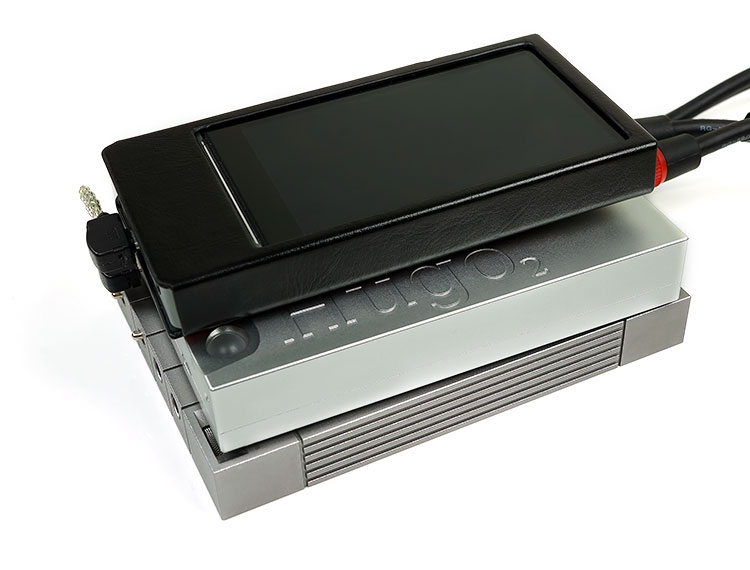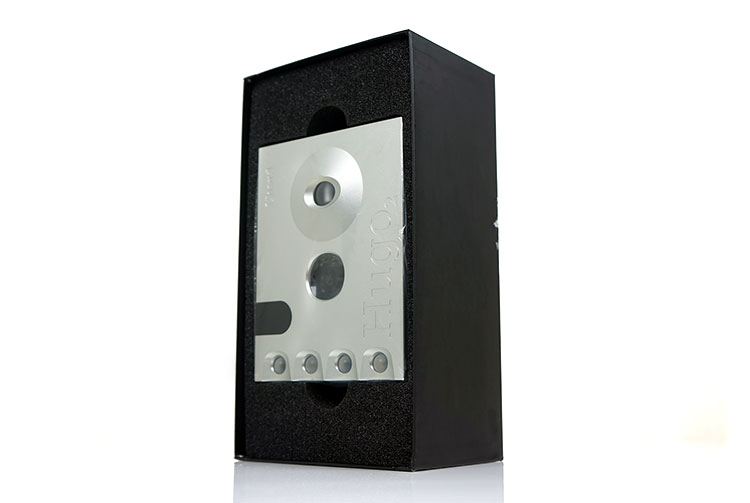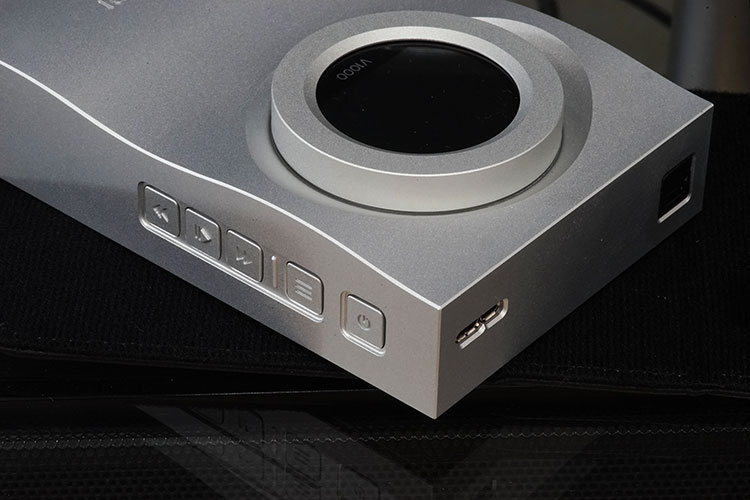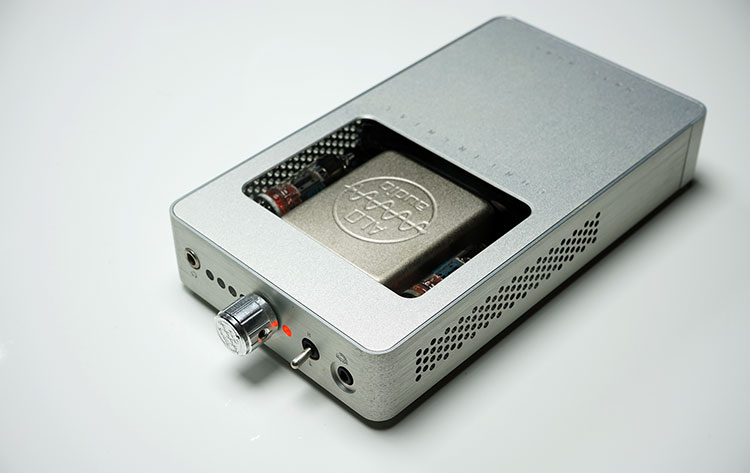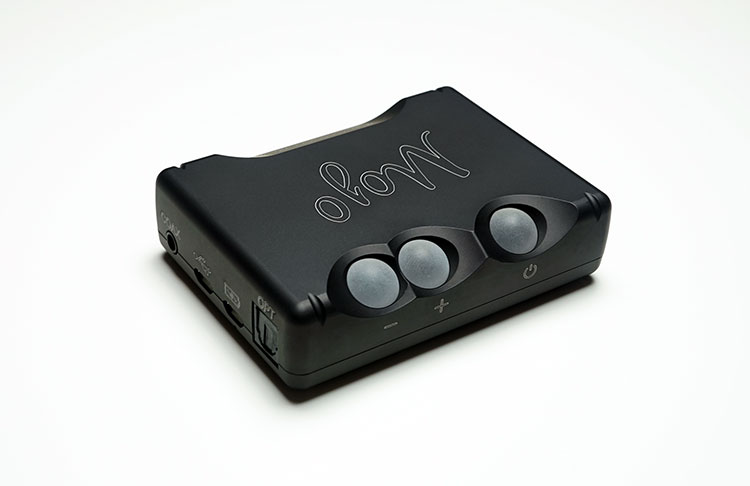Sound Impressions
Tonality & Presentation
The Hugo 2 has an incredibly coherent response and when stacked up against the Hugo 1 you get a much better sense of balance in the overall presentation. Nothing stands out as being overly colored or emphasized yet the detail and clarity have gone up a notch.
You could argue that the response is largely neutral but I would say there is a slight, and I mean a very slight, bias to a more natural sound with a smoother attack, particularly in bass and treble which is a lot more refined than before.
Certainly, the levels of transparency are much better on the Hugo 2 and in comparison to the Hugo 1 the level of accuracy in both instrumental timbre, speed, and control is more convincing and involving.
The older Hugo’s coloration always had this knack of drawing you into certain aspects of the performance at the cost of some other areas with bass and vocals to the fore and a slight smoothing of lower mids some way behind. Not so on the Hugo 2 where clarity and detail in these areas are now much superior and a little bit more engaging.
Bass
The bass response is now more linear on the Hugo 2 with superior texture and detail compared to the more excitable but looser low-end of the Hugo 1. The bass signature on the Hugo 1 comes across as a bit warmer, perhaps fuller-sounding but also softer and not quite as well defined or accurate sounding as the Hugo 2.
The additional bloom and a slightly thicker more elevated mid-bass of the Hugo 1 do make it the more “musical” of the two but if you listen carefully the Hugo 2’s low-end is the tighter and quicker of the two.
That linear more neutral positioning also affords a bit more space and focus on the Hugo 2’s presentation of lower-pitched instrumental notes. The nuanced detail on double bass and cello plucks from E1 up are cleaner and more palatable to the ear.
Mids
The Hugo 1 has a bit more in terms of lower mids warmth so it sounds a little less defined and softer than the Hugo 2 level of detail and control. As such, I tended to miss a little bit in terms of instrumental complexity and instead focused more on vocals, upper mids, and bass with the Hugo 1.
By comparison, instrumental separation and imaging are a bit cleaner and more precise on the Hugo 2. That lowering of the previous Hugo’s warmth and going instead with a more linear response on the Hugo 2 makes a big difference, particularly for complex guitar, bass guitar, or lower string clarity.
Vocals
Vocals are more neutral in both their tonality and positioning on the Hugo 2. The Hugo 1 vocals sound a little bit more vivid or forward-sounding. They grab your attention quicker but they also sound a little harder-edged and less forgiving by comparison.
Timbre
I always felt odd harmonics had a bit more emphasis when speaking about the timbre on the Hugo 1. Engineering quirks on vocals that digitize and use autotune, especially on note attacks, will sound a bit sharper sounding with the Hugo 1 when played alongside the Hugo 2.
The harmonics balance is just that little bit better on the Hugo 2 so even if the recording is sharp it doesn’t amplify quite as much as the Hugo 1 which tends to throw out some sharper partial overtones. Overall a slightly smoother and more natural sounding timbre on the Hugo 2.
Treble
The top end of Hugo 1, though articulate and lively, has a slightly harder edge to the lower treble performance compared to Hugo 2. The Hugo 2 has a more natural-sounding top end and a little easier on the ear.
The Hugo 2 treble is also more articulate and delivers a more confident level of nuanced detail right up its brilliance response making it the more balanced sounding of the two with greater headroom and a little more air.
Synergy
You will probably notice that I have omitted to discuss any amp stage specs of the Hugo 2 up until this point. It is not an omission rather it’s an acknowledgment of the fact Chord designed the Hugo 2 without any traditional amping stage (opamp, buffer, gain, etc). Rob Watt’s offers a detailed explanation of how the Hugo 2 works specifically for amplification:
The FPGA creates the digital signals to be fed into the pulse array discrete DAC. A flip-flop is a synchronous 1 bit memory device. The output will take the value of the input (in this case) on a rising edge of the clock. So why do I use flip-flops? Two basic reasons:
1. The output from an FPGA has a lot of signal correlated and random jitter on the pulse array waveforms. Putting it through a flip-flop removes the jitter to an insignificant level (confirmed through measurement).
2. The output from the FPGA is very noisy – using a flip-flop you eliminate the FPGA noise, and you are left with the noise on the flip-flop’s power supply – and this is designed to be extraordinary low noise (0.3uV) and extremely low impedance (0.0005 ohms – if this was a power amp it would be a damping factor of 16,000).
This ultra low impedance is essential to remove reference induced distortion, and amplitude modulation (AM) from the music envelope from changing the gain of the system. Music envelope AM is very damaging to the sound quality, particularly with bass perception.
So they flip-flop together with the reference supply, means we have a extremely low noise and jitter. The analogue section is just a single stage amp, coupled via individual resistors from each flip-flop.
Channel Balance
A few things arise out of this specific design. The first is that there is no analog volume control, it is entirely digital which means channel imbalance and other associated analog design quirks do not exist on the Hugo 2. Whether you use a Campfire Andromeda, AKG K812 or an RHA CL1 you will get a clean and steady voltage control and volume rise without any channel bias on low volumes.
Noise Performance
The second is the performance specs of the Hugo 2 making this one heck of a dynamic range and good low noise performer on all but the most sensitive of IEMs.
You will detect a little bit of background hiss with the like of the Andromeda so it is not completely silent and less so than the Aurender Flow and marginally higher than the Mojo. However, the Flow picks up a little more RF than the Hugo 2 (Hugo is not RF free though) on OTG, something I think the Chord learned a lot from with the Mojo RF feedback using smartphones.
Impedance
Output impedance on the Hugo 2 is really low at 0.025Ω which significantly contributes to that lack of coloration in its tonality. It won’t suck out the bass on your sensitive BA configs nor will it dramatically alter the inherent tone of whatever you plug into it.
As a point of reference, the output impedance that is even lower than the Mojo at 0.075Ω, more competitive than the Aurender Flow at 0.06Ω, and we have to assume far more accurate and lower than the Continental Dual Mono at < 1 Ohm. I pick these ones out specifically because they really are all in that same portable/transportable DAC/Amp class as the Hugo 2.
Output Power
At the same time, the output ratings under loads are excellent for a transportable DAC/Amp at 740mW for 32Ω loads and just over 1W for 8Ω. For higher impedance and ultra-inefficient headphones, I would recommend using the Hugo 2 as a DAC and plugging it into a more powerful desktop amp such as the Cayin iHA-6 and its 7W output capability.
As a point of comparison, the Hugo 2 dwarfs similar class devices such as the Continental Dual Mono which can only manage 80mW single and 125mW balanced into 32 ohms and spanks the Flow’s 380 mW/32 ohms. The Mojo comes a lot closer at 600mW into 32 ohms which is excellent given its size.
Headphones & IEMs
Primarily for heavy-duty headphones such as the Hifiman HE-6 and Susvara using the Hugo 2 as a DAC line level out to a dedicated desktop amp is ideal. Modern planars such as the LCD-2, Ether, and Ether Flow, however, have no driving issues paired with the Hugo 2. All have excellent dynamics and detail and none of them sounding short of power.
Having said that users of the RHA CL1 150 ohm monster, as well as the power-hungry Vega and Flares Pro, will be particularly delighted with the performance of the Hugo 2. It presents no issues on voltage control as well as driving these DD designs with maximum ease. Possibly some of the best pairings I have heard to date for clarity and timing.
Digital Only
The final point is the lack of analog inputs. Much like the Hugo 1 and Mojo the FPGA design and lack of analog amplification stage independent to the DAC means there is no capability to pick up on an analog signal and output it directly on the Hugo 2. Everything coming in must be digital.
This means in terms of matchability you cannot pair another source a line out to the Hugo 2, it must be OTG, optical or coaxial, and Bluetooth.
Analog Out (Dual RCA)
Default Output
The analog output of the Hugo 2 is excellent and one of the best in its category. However, comparing the voltage line out of the Hugo 2 to some of its competitors and even some desktop units you can see that the Hugo 2’s line out Vrms is the same as the Mojo at 3Vrms.
Adjusting and Matching
Desktop units such as the Oppo Sonica DAC, Cayin iDAC-6, CDM and DAC-1 from NuPrime all float in-between 2Vrms and 2.4Vrms so this is actually a touch higher than the norm. You can opt to reduce the line out Vrms rating in the same manner as the Mojo to whatever level you wish below 3Vrms if the response on your amp is a bit “too lively”. You can also go even higher, much higher almost to 5Vrms, before clipping with the pure white or final color code on the volume control.
Color Coordination
Your only problem with that is the linear control of the voltage on the Hugo is not as precise as the stepped control of the Mojo. Four clicks on the Mojo get you 1.9V which is good enough.
On the Hugo 2, it’s more of an estimation based on the color scheme relative to the Violet coding of the 3V default. My best guess is dark green to blue for 2V then fine-tune until you are happy with the output on your amp.
Bluetooth
BT range has effectively doubled over the original Hugo 1 in our testing. It just about hits the default range we normally aim for with dedicated smartphone BT receivers though it is a touch shorter with some DAPs.
Not so much a reflection of the Hugo 2 BT capability and more to do with the strength or the BT receivers on individual sources. In this test case, we got around 5-8m with one wall barrier between myself and the source.
That being said it is a touch fussier than the BT signal from the DX200 and X7iii and is more prone to ‘line of sight’ barrier drop out but in all a vastly superior experience to the first-gen Hugo which dropped out around 2 meters away with no barrier.
Select Comparisons
Aurender Flow
$1295
The Flow was released around the Hugo 1 and for a time locally we did ask if this was a Hugo killer. Sadly it did not turn out to be the case but it is very competent if slightly aged, transportable DAC/Amp.
Much like the Hugo 2, it is solid and bigger than pocket-friendly but diminutive in terms of desktop components. It can act on its own with its incorporated DAC and amp, or serve as pure DAC in a bigger desktop system.
Physical & Battery
Compared to Hugo 1 the Flow would be slightly more intuitive of the two to use and operate. The Hugo 2’s physical redesign and better physical control layout though is now much superior to them both. With the additional USB charging now added it is also a lot readier for “pick up and go” than before.
It is battery powered much like the Hugo 2 with similar battery performance at around 7 hours. Like the Hugo 2 is can handle a wide range of connections including OTG, PC-DAC out, analog out and optical out.
Unique Features
What it does not have is a Bluetooth output of any form or coaxial input. It is also short of a 3.5mm jack output so you will need a quarter jack adapter which Aurender has provided. The Flow uses 3.0 as opposed to micro USB 2.0 but you can use 2.0 cables with it. They have also provided a wealth of cables for connections such as quarter to dual RCA, optical, USB 3.0.
What the Flow does have is the unusual mSATA slot to act as an HDD storage for audio files. However, it does not play them by itself, consider it an HDD and you have to access them through a PC or similar device. It has its niche uses but not something that could be called an overwhelming advantageous feature.
DAC & Amp
Like the Hugo 2, the Flow also has a series of digital filters but is based on the lower spec’ed and older ES9018K2M chipset and is only capable of up to 32-bit/384kHz with DSD64/128 capability.
In terms of output power, the Hugo 2 easily outguns the Flow at 740mW into 32 ohms compared to 380 mW. The Flow’s noise level is slightly lower, perhaps more due to the lower output numbers. The Flow’s impedance is competitive at 0.06 ohms but not as low as the Hugo 2’s 0.025 ohms.
Sound
Both devices err more to the neutral to the natural side, however, the Hugo 2 is the more resolving, detailed, and balanced of the two. From top to bottom the Hugo 2 presents much more audible information from texture, to instrumental separation as well as more accurate imaging.
The Flow, much like the Hugo 1, has a little bit more bloom in the low end and a slightly softer bass response compared to the snappier and more detailed Hugo 2.
I am still impressed by how Aurender managed to avoid Sabre glare in the Flow’s signature so that slightly soft attack is evident even in its treble response making it one of the better Es9018 implementations out there with impressive headroom.
The Hugo 2 though has a bit more sparkle and clarity and doesn’t need to revert to any softening so it comes across as more accurate yet still quite natural sounding and very refined.
Perhaps the biggest difference is the mids performance. The Hugo 2 instrumental layering is excellent with superb imaging.
Vocals are neutral but accurate also. The Flow’s mids, in contrast, are nothing special and vocals only seem to perform on operatic or classical where it’s not so essential to have a guttural performance. I don’t get the same level of detail and texture from Flow’s vocal performance which leaves me a bit cold.
ALO Audio Continental Dual Mono
$1495
Technical
For me, the CDM and the Hugo 2 are chalk and cheese, and happily, I have them side by side. Technically the Hugo 2 is far superior with high rates of decoding up to 768kHz/32-bit with a native DSD playback capability of up to DSD512 compared to the CDM’s more limited delta-signal Wolfson WM8741 performance of just DSD64 and 192kHz/24-bit.
Power
Again, a similar pattern on output power with the CDM capable of a modest 80mW into 32 ohms and 125mW into 32 ohms balanced compared to the Hugo 2’s very ample 740mW into 32 ohms. It also has a higher noise floor than the Hugo 2, lacks Bluetooth but can match for OTG with Android devices via USB, and also operates as a USB-DAC out.
Analog vs Digital
You can also use the CDM as a pure DAC but unlike the Hugo 2, it can take an analog line-level source input in both balanced and unbalanced whereas the Hugo 2 is entirely digital. Both can line level out with the CDM default at 2V and Hugo 2 at 3V.
Sound
Of course, the big difference and the reason why I think the CDM is entirely complementary to the Hugo 2 is the hybrid tube design which not only brings in a contrasting tonal character but also an additional shelf-life through possible rolling options.
ALO did a great job injecting a really nice tube-like quality into the CDM with a euphoric timbre, a smooth if a slightly languid pace, and laid-back treble response that I find very pleasing to a sometimes tired ear.
It is not as resolving as the Hugo 2, staging is not as expansive nor is the micro-detail quite as palatable or noticeable. The Wolfson Wm8741 is never going to beat the prowess of the Hugo 2 decoding.
However, its amp and tube design behind the CDM is sublime and full of analog character. I never really use the CDM though to hear the pinnacle of detail in my recordings, if anything I use it for switching off from “reviewing” and just connect a bit more with whatever I am listening to.
It is a fantastic pairing to take the digital or solid-state edge off any desktop amp, heck why not even pair it with a Hugo 2 and get the best of both worlds.
Chord Mojo
$599
The Mojo cut a path for the Hugo 2 in so many ways with the better orb control, more media-savvy connectivity as well as packing much of the tech inside that is now used and enhanced inside the Hugo 2. In a way, the Mojo was just as much a factor in the Hugo 2 design as the older Hugo 1.
Technical
Specs-wise the Mojo really does well now stacked up against the older Hugo with similar tap length but decoding almost up to Hugo 2 levels at 768kHz/32-bit and DSD512. Output power is not quite as strong as the Hugo 2 at 600mW into 32 ohms but certainly a little higher than the older Hugo 1 output spec sheet.
The biggest differentiation though is the purpose of the connectivity. Whilst you can use a Mojo as a pure DAC with a line-level output level similar to the Hugo 2 at 3V.
Chord really does not play up this type of use. The Mojo is intended to be purely portable so its primary design is shaped around its OTG, USB-DAC, optical and coaxial inputs, and a superior battery life of 8-10 hours.
Sound
The Mojo tonality is not a million miles away from the Hugo 2. Both are natural performers and if I had to sum the Mojo sound it is a grab for the Hugo 2 tonal quality with the technical resolution and detail of the Hugo 1.
What does the Hugo 2 do that is better? Dynamics for me and better energy with a more coherent presentation as well as a superior level of detail. I also find the Hugo 2 just to be that bit more accurate with its staging, timbre, and imaging.
The Mojo is just a little bit more relaxed in comparison. I still love the low end of the Mojo though, it’s got a really nice PRaT and in some ways retains the spirit of the Hugo 1’s fuller low end but not quite as soft.
Just as a side note you can give the Hugo 2 a little more “Mojo” flavor with X-PHD, especially the digital filter 03 which puts a dash of additional warmth and a slightly smoother denser sound.
Our Verdict
The Hugo 2 is a DAC and then some. In some ways, I am convinced the Hugo 2 is the lovechild of the Mojo and Hugo 1, such is the degree of harmony of the two designs. Would the Hugo 2 have been possible without the Mojo? I doubt it.
The design has been upgraded, it’s now easier to understand. The Mojo Orb system has been enhanced. The filters actually work and the switching in functionality including the cross-field functions do make a usability difference as well as an audible change. Everything on the Hugo 2 feels ‘important, there is simply nothing superfluous in its functionality.
I have been guilty of using my old Hugo 1 as a component system far too much but with the Hugo 2’s much better design, superior BT capability, and more enjoyable amp I am unplugging the next-gen a whole lot more.
It is still transportable, heck even the battery life takes a dip but actually, this feels more satisfying to use as a portable device. I honestly can’t think of a single transportable DAC device out on the market today that can beat the Hugo 2 for pure sound. That bodes well for the end of the year awards.
Chord Electronics Hugo 2 Specifications
- Chipset: Chord Electronics custom-coded Xilinx Artix 7 (XC7A15T) FPGA
- Tap-length: 49,152
- Pulse array: 10-element pulse array design
- Frequency response: 20Hz – 20kHz +/- 0.2dB
- Output stage: Class A
- Output impedance: 0.025Ω
- THD: <0.0001% 1kHz 3v RMS 300Ω
- THD and noise at 3v RMS: 120dB at 1kHz 300ohms ‘A’ weighted (reference 5.3v)
- Noise 2.6 uV ‘A’ weighted: No measurable noise floor modulation
- Signal to noise ratio: 126dB ‘A’ Weighted
- Channel separation: 135dB at 1kHz 300Ω
- Power output @ 1kHz 1% THD: 94mW 300Ω
- 740mW 32Ω
- 1050mW 8Ω
- Weight: 450g
- Dimensions: 130mm (L) x 100mm (W) x 21mm (H)
- Boxed Dimensions: 220mm (L) x 122mm (W) x 85mm (H)



